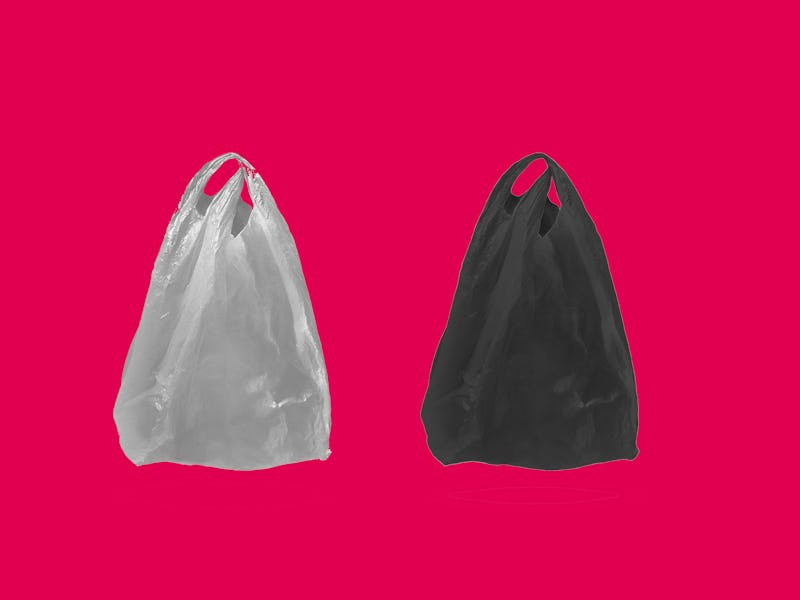A new study holds promise for the second life of a plastic bag
Old shopping bags are finally more than just bags to hold more bags.

The problem with plastic is simple: We produce hundreds of millions of tons each year, and it basically never disappears. Figuring out what to do with all that waste, on the other hand, is a lot more complicated. Fortunately, scientists just got one step closer to figuring it out.
Polyethylene, the world’s most widely used plastic, is created from the “cracking of ethane and propane, naphtha and gas oil,” and a chemical reaction can transform it back into oil — motor oil and lubricants.
And with even more processing, it can even be turned into detergents and cosmetics, shows a study published Wednesday in the American Chemical Society journal ACS Central Science.
With the new process, materials usually treated as garbage — like bubble wrap and plastic grocery bags — can get a second life while also creating useful tools for everyday life.
The work is exciting because it could take real strides toward reducing single-use plastic waste, says Massimiliano Delferro, Ph.D., group leader of the Catalysis Science Program at Argonne National Laboratory and co-corresponding author on the new study.
“We discovered something that could be really impactful for human beings,” Delferro tells Inverse.
Scientists just got one step closer to closing the loop on plastic waste.
To achieve this goal, Delferro’s team used platinum nanoparticles to catalyze the chemical reaction that breaks down polyethylene. Developing the catalyst, which took more than a year, provides a new method of getting rid of persistent plastics, a huge — and increasing — environmental concern.
“This, for me, is really exciting,” Delferro says. “Scientists worked for almost 70 years making new plastics…and you spend a year to do the opposite.”
Researchers had previously figured out how to convert polyethylene into liquid fuels and waxes, but the new method introduces even more new possibilities.
Recycling plastic often degrades materials, so although they’re able to be reused, they lose some of their original properties. Plastic bottles lose their strength and color, for example, in typical recycling processes that “downcycle.”
The new chemical reaction, on the other hand, is an opportunity for “upcycling.” Flimsy plastic bags can become high-quality liquids that help lubricate car engines.
The key is how carbon molecules are split up and arranged, the researchers say. Their method, which uses a platinum nanoparticle catalyst to break down the plastic and create a substance with a longer chain of hydrocarbons, can be used as a “building block” for a number of products.
A platinum nanoparticle catalyst helps break the bonds in polyethylene to create new materials, including engine oil.
Despite the many documented issues with plastic waste all over the globe, plastic does have many benefits, Delferro says. Its development has been huge for transportation, food preservation, and medicine.
“At the end, it’s a good thing; it’s made our lives much better,” Delferro says. “But it’s the single-use plastics that are a problem.”
The new method could eliminate waste from products that are often used for just a few hours before spending thousands of years in a landfill.
The method isn’t yet ready to go commercial, but with more development, there’s potential to implement the technology at a wide scale, Delferro says.
“There are a lot of opportunities to take what we have in the lab to the market,” he says.
The research team is continuing to study other methods of recycling plastics, for example recycling multiple types of plastic at once.
“We think that in addition to that there are other opportunities there, Delferro says. As a scientist and a human, he says future possibilities are exciting, because “we can really be impacted.”
Abstract: Our civilization relies on synthetic polymers for all aspects of modern life; yet, inefficient recycling and extremely slow environmental degradation of plastics are causing increasing concern about their widespread use. After a single use, many of these materials are currently treated as waste, underutilizing their inherent chemical and energy value. In this study, energy-rich polyethylene (PE) macromolecules are catalytically transformed into value-added products by hydrogenolysis using well-dispersed Pt nanoparticles (NPs) supported on SrTiO^^3 perovskite nanocuboids by atomic layer deposition. Pt/SrTiO^^3 completely converts PE (M^^n = 8000− 158,000 Da) or a single-use plastic bag (M^^n = 31,000 Da) into high-quality liquid products, such as lubricants and waxes, characterized by a narrow distribution of oligomeric chains, at 170 psi H^^2 and 300 °C under solvent-free conditions for reaction durations up to 96 h. The binding of PE onto the catalyst surface contributes to the number averaged molecular weight (M^^n) and the narrow polydispersity (Đ) of the final liquid product. Solid-state nuclear magnetic resonance of 13C-enriched PE adsorption studies and density functional theory computations suggest that PE adsorption is more favorable on Pt sites than that on the SrTiO^^3 support. Smaller Pt NPs with higher concentrations of undercoordinated Pt sites over-hydrogenolyzed PE to undesired light hydrocarbons.